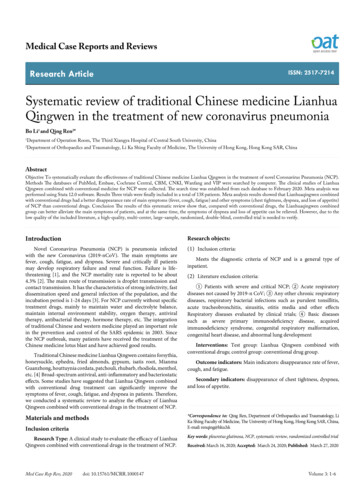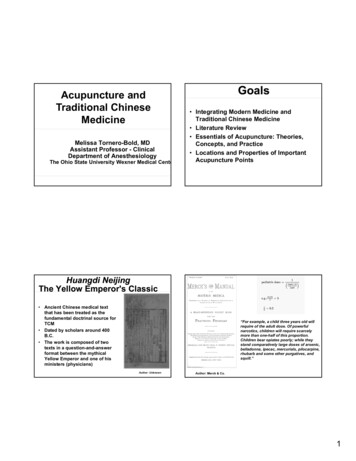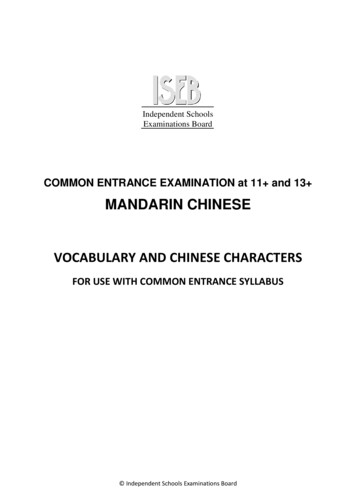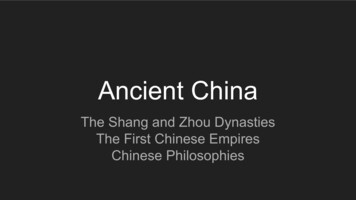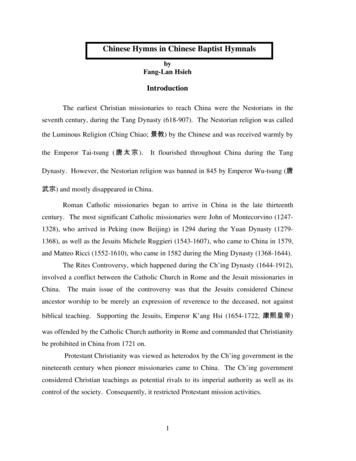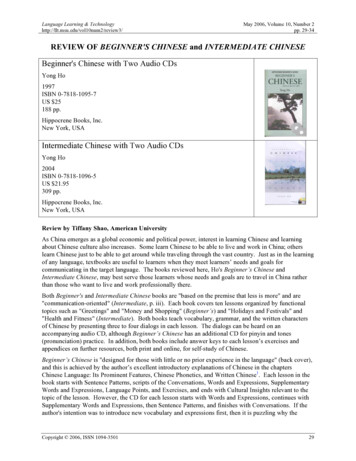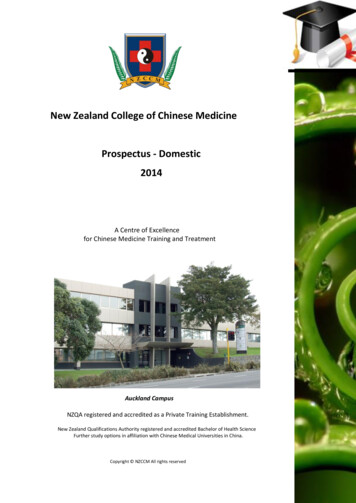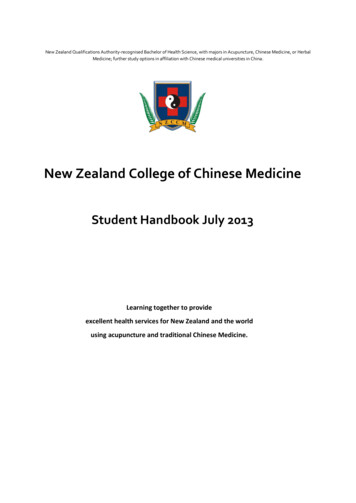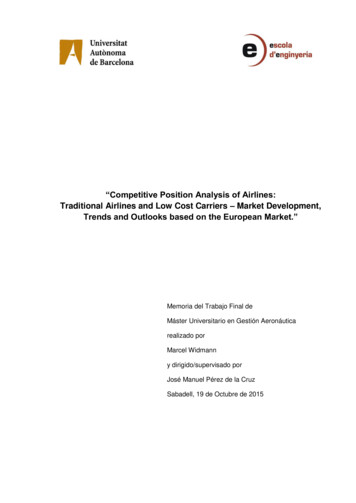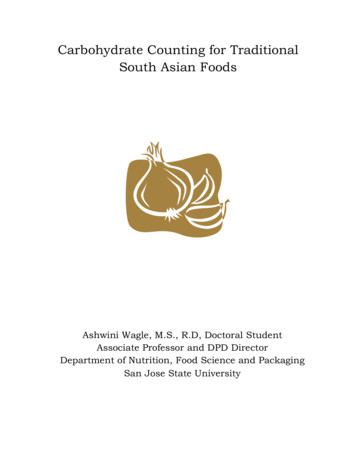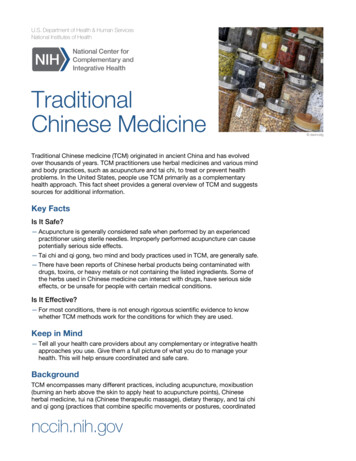
Transcription
U.S. Department of Health & Human ServicesNational Institutes of HealthTraditionalChinese MedicineTraditional Chinese medicine (TCM) originated in ancient China and has evolvedover thousands of years. TCM practitioners use herbal medicines and various mindand body practices, such as acupuncture and tai chi, to treat or prevent healthproblems. In the United States, people use TCM primarily as a complementaryhealth approach. This fact sheet provides a general overview of TCM and suggestssources for additional information.Key FactsIs It Safe?— Acupuncture is generally considered safe when performed by an experiencedpractitioner using sterile needles. Improperly performed acupuncture can causepotentially serious side effects.— Tai chi and qi gong, two mind and body practices used in TCM, are generally safe.— There have been reports of Chinese herbal products being contaminated withdrugs, toxins, or heavy metals or not containing the listed ingredients. Some ofthe herbs used in Chinese medicine can interact with drugs, have serious sideeffects, or be unsafe for people with certain medical conditions.Is It Effective?— For most conditions, there is not enough rigorous scientific evidence to knowwhether TCM methods work for the conditions for which they are used.Keep in Mind— Tell all your health care providers about any complementary or integrative healthapproaches you use. Give them a full picture of what you do to manage yourhealth. This will help ensure coordinated and safe care.BackgroundTCM encompasses many different practices, including acupuncture, moxibustion(burning an herb above the skin to apply heat to acupuncture points), Chineseherbal medicine, tui na (Chinese therapeutic massage), dietary therapy, and tai chiand qi gong (practices that combine specific movements or postures, coordinatednccih.nih.gov davincidig
National Center for Complementary and Integrative HealthTraditional Chinese Medicinebreathing, and mental focus). TCM is rooted in the ancient philosophy of Taoismand dates back more than 2,500 years. Traditional systems of medicine also exist inother East and South Asian countries, including Japan (where the traditional herbalmedicine is called Kampo) and Korea. Some of these systems have been influencedby TCM and are similar to it in some ways, but each has developed distinctivefeatures of its own.Although the exact number of people who use TCM in the United States isunknown, it was estimated in 1997 that some 10,000 practitioners served more than1 million patients each year. According to the 2007 National Health Interview Survey(NHIS), which included a comprehensive survey on the use of complementary healthapproaches by Americans, an estimated 3.1 million U.S. adults had usedacupuncture in the previous year. The number of visits to acupuncturists tripledbetween 1997 and 2007. According to the 2007 NHIS, about 2.3 million Americanspracticed tai chi and 600,000 practiced qi gong in the previous year.This fact sheet focuses on TCM as a whole. For information about some of theindividual practices included in TCM, see the pages on acupuncture (nccih.nih.gov/health/acupuncture), tai chi (nccih.nih.gov/health/taichi), and qi gong (nccih.nih.gov/taxonomy/term/249) on the National Center for Complementary and IntegrativeHealth (NCCIH) Web site. Some of the individual herbs used in TCM are discussedin NCCIH’s Herbs at a Glance eBook and fact sheets (nccih.nih.gov/health/herbsataglance.htm).Side Effects and Risks— Herbal medicines used in TCM are sometimes marketed in the United States asdietary supplements. The U.S. Food and Drug Administration (FDA) regulationsfor dietary supplements are not the same as those for prescription or over-thecounter drugs; in general, the regulations for dietary supplements are lessstringent. For example, manufacturers don’t have to prove to the FDA that mostclaims made for dietary supplements are valid; if the product were a drug, theywould have to provide proof.— Some Chinese herbal products may be safe, but others may not be. There havebeen reports of products being contaminated with drugs, toxins, or heavy metalsor not containing the listed ingredients. Some of the herbs used in Chinesemedicine can interact with drugs, can have serious side effects, or may be unsafefor people with certain medical conditions. For example, the Chinese herbephedra (ma huang) has been linked to serious health complications, includingheart attack and stroke. In 2004, the FDA banned the sale of ephedra-containingdietary supplements, but the ban does not apply to TCM remedies.— The FDA regulates acupuncture needles as medical devices and requires that theneedles be sterile, nontoxic, and labeled for single use by qualified practitionersonly. Relatively few complications from the use of acupuncture have beenreported. However, adverse effects—some of them serious—have resulted fromthe use of nonsterile needles or improper delivery of acupuncture treatments.— Tai chi and qi gong are considered to be generally safe practices.— Information on the safety of other TCM methods is limited. Reportedcomplications of moxibustion include allergic reactions, burns, and infections, buthow often these events occur is not known. Both moxibustion and cupping(applying a heated cup to the skin to create a slight suction) may mark the skin,usually temporarily. The origin of these marks should be explained to health careproviders so that they will not be mistaken for signs of disease or physical abuse.2
National Center for Complementary and Integrative HealthTraditional Chinese MedicineUnderlying Concepts and TheoriesWhen thinking about ancient medical systems such as TCM, it is important toseparate questions about traditional theories and concepts of health and wellnessfrom questions about whether specific interventions might be helpful in the contextof modern science-based medicine and health promotion practices.The ancient beliefs on which TCM is based include the following:— The human body is a miniature version of the larger, surrounding universe.— Harmony between two opposing yet complementary forces, called yin and yang,supports health, and disease results from an imbalance between these forces.— Five elements—fire, earth, wood, metal, and water—symbolically represent allphenomena, including the stages of human life, and explain the functioning ofthe body and how it changes during disease.— Qi, a vital energy that flows through the body, performs multiple functions inmaintaining health.Concepts such as these are of interest in understanding the history of TCM. However,NCCIH-supported research on TCM does not focus on these ideas. Instead, itexamines specific TCM practices from a scientific perspective, looking at their effectsin the body and whether the practices are helpful in symptom management.TCM practitioners use a variety of techniques in an effort to promote health andtreat disease. In the United States, the most commonly used approaches includeChinese herbal medicine, acupuncture, and tai chi.— Chinese herbal medicine. The Chinese Materia Medica (a pharmacologicalreference book used by TCM practitioners) describes thousands of medicinalsubstances—primarily plants, but also some minerals and animal products.Different parts of plants, such as the leaves, roots, stems, flowers, and seeds, areused. In TCM, herbs are often combined in formulas and given as teas, capsules,liquid extracts, granules, or powders.— Acupuncture. Acupuncture is a family of procedures involving the stimulation ofspecific points on the body using a variety of techniques. The acupuncturetechnique that has been most often studied scientifically involves penetrating theskin with thin, solid, metal needles that are manipulated by the hands or byelectrical stimulation.— Tai chi. Tai chi is a centuries-old mind and body practice. It involves gentle,dance-like body movements with mental focus, breathing, and relaxation.The Status of TCM ResearchIn spite of the widespread use of TCM in China and its use in the West, rigorousscientific evidence of its effectiveness is limited. TCM can be difficult for researchersto study because its treatments are often complex and are based on ideas verydifferent from those of modern Western medicine.3
National Center for Complementary and Integrative HealthTraditional Chinese MedicineMost research studies on TCM have focused on specific techniques, primarilyacupuncture and Chinese herbal remedies, and there have been many systematicreviews of studies of TCM approaches for various conditions.— An assessment of the research found that 41 of 70 systematic reviews of thescientific evidence (including 19 of 26 reviews on acupuncture for a variety ofconditions and 22 of 42 reviews on Chinese herbal medicine) were unable to reachconclusions about whether the technique worked for the condition underinvestigation because there was not enough good-quality evidence. The other 29systematic reviews (including 7 of 26 reviews on acupuncture and 20 of 42 reviewson Chinese herbal medicine) suggested possible benefits but could not reachdefinite conclusions because of the small quantity or poor quality of the studies.— In a 2012 analysis that combined data on individual participants in 29 studies ofacupuncture for pain, patients who received acupuncture for back or neck pain,osteoarthritis, or chronic headache had better pain relief than those who did notreceive acupuncture. However, in the same analysis, when actual acupuncturewas compared with simulated acupuncture (a sham procedure that resemblesacupuncture but in which the needles do not penetrate the skin or penetrate itonly slightly), the difference in pain relief between the two treatments was muchsmaller—so small that it may not have been meaningful to patients.— Tai chi has not been investigated as extensively as acupuncture or Chineseherbal medicine, but recent studies, including some supported by NCCIH,suggest that practicing tai chi may help to improve balance and stability in peoplewith Parkinson’s disease; reduce pain from knee osteoarthritis and fibromyalgia;and promote quality of life and mood in people with heart failure.If You Are Thinking About Using TCM— Do not use TCM to replace effective conventional care or as a reason topostpone seeing a health care provider about a medical problem.— Look for published research studies on TCM for the health condition thatinterests you.— It is better to use TCM herbal remedies under the supervision of your health careprovider or a professional trained in herbal medicine than to try to treat yourself.— Ask about the training and experience of the TCM practitioner you areconsidering. You can find information about the credentials and licensing ofcomplementary health practitioners on the NCCIH Web site at �� If you are pregnant or nursing, or are thinking of using TCM to treat a child, youshould be especially sure to consult your (or the child’s) health care provider.— Tell all your health care providers about any complementary or integrative healthapproaches you use. Give them a full picture of what you do to manage yourhealth. This will help ensure coordinated and safe care.4
National Center for Complementary and Integrative HealthTraditional Chinese MedicineKey ReferencesBirdee GS, Wayne PM, Davis RB, et al. T’ai chi and qigong for health: patterns of use in the United States.Journal of Alternative and Complementary Medicine. 2009;15(9):969-973.Chan E, Tan M, Xin J, et al. Interactions between traditional Chinese medicines and Western therapeutics.Current Opinion in Drug Discovery & Development. 2010;13(1):50-65.Kaptchuk TJ. The Web That Has No Weaver: Understanding Chinese Medicine. 2nd ed. New York, NY:McGraw-Hill, 2000.Ko RJ. A U.S. perspective on the adverse reactions from traditional Chinese medicines. Journal of theChinese Medical Association. 2004;67(3):109-116.Li CG, Moyle K, Xue CC. Problems and challenges of Chinese herbal medicine. In: Leung P-C, Xue CC,Cheng Y-C, eds. A Comprehensive Guide to Chinese Medicine. River Edge, NJ: World ScientificPublishing Co.; 2003.Manheimer E, Wieland S, Kimbrough E, et al. Evidence from the Cochrane Collaboration for traditionalChinese medicine therapies. Journal of Alternative and Complementary Medicine. 2009;15(9):1001-1014.O’Brien KA, Xue CC. The theoretical framework of Chinese medicine. In: Leung P-C, Xue CC, Cheng Y-C,eds. A Comprehensive Guide to Chinese Medicine. River Edge, NJ: World Scientific Publishing Co.; 2003.Vickers AJ, Cronin AM, Maschino AC, et al. Acupuncture for chronic pain: individual patient data metaanalysis. Archives of Internal Medicine. 2012;172(19):1444-1453.Xue CC, O’Brien KA. Modalities of Chinese medicine. In: Leung P-C, Xue CC, Cheng Y-C, eds. AComprehensive Guide to Chinese Medicine. River Edge, NJ: World Scientific Publishing Co.; 2003.For More InformationNCCIH ClearinghouseThe NCCIH Clearinghouse provides information on NCCIH and complementary andintergrative health approaches, including publications and searches of Federaldatabases of scientific and medical literature. The Clearinghouse does not providemedical advice, treatment recommendations, or referrals to practitioners.Toll-free in the U.S.: 1-888-644-6226TTY (for deaf and hard-of-hearing callers): 1-866-464-3615Web site: nccih.nih.govE-mail: info@nccih.nih.govPubMed A service of the National Library of Medicine, PubMed contains publicationinformation and (in most cases) brief summaries of articles from scientific andmedical journals.Web site: www.ncbi.nlm.nih.gov/pubmedThe Cochrane Database of Systematic ReviewsThe Cochrane Database of Systematic Reviews is a collection of evidence-basedreviews produced by the Cochrane Library, an international nonprofit organization.The reviews summarize the results of clinical trials on health care interventions.Summaries are free; full-text reviews are by subscription only.Web site: www.cochranelibrary.com5
National Center for Complementary and Integrative HealthTraditional Chinese MedicineNIH Clinical Research Trials and YouThe National Institutes of Health (NIH) has created a Web site, NIH Clinical ResearchTrials and You, to help people learn about clinical trials, why they matter, and howto participate. The site includes questions and answers about clinical trials,guidance on how to find clinical trials through ClinicalTrials.gov and other resources,and stories about the personal experiences of clinical trial participants. Clinical trialsare necessary to find better ways to prevent, diagnose, and treat diseases.Web site: www.nih.gov/health/clinicaltrials/Research Portfolio Online Reporting Tools Expenditures & Results(RePORTER)RePORTER is a database of information on federally funded scientific and medicalresearch projects being conducted at research institutions.Web site: projectreporter.nih.govAcknowledgmentsNCCIH thanks the following people for their technical expertise and review of theupdate of this publication: Adam Burke, Ph.D., M.P.H., L.Ac., San Francisco StateUniversity; Ted Kaptchuk, O.M.D., Harvard Medical School; Lixing Lao, M.D., Ph.D.,L.Ac., University of Maryland Medical Center; and Wendy Weber, N.D., Ph.D.,M.P.H., and John (Jack) Killen, Jr., M.D., NCCIH.This publication is not copyrighted and is in the public domain.Duplication is encouraged.NCCIH has provided this material for your information. It is not intended to substitute for themedical expertise and advice of your primary health care provider. We encourage you todiscuss any decisions about treatment or care with your health care provider. The mention ofany product, service, or therapy is not an endorsement by NCCIH.U.S. Department of Health & Human Services National Institutes of Health National Center for Complementary and Integrative Healthnccih.nih.govD428—Created March 2009—Updated October 20136
Aug 03, 2015 · Key Facts . Is It Safe? — Acupuncture is generally considered safe when performed by an experienced practitioner using sterile needles. Improperly performed acupuncture can cause potentially serious side effects. — Tai chi and qi gong, two
